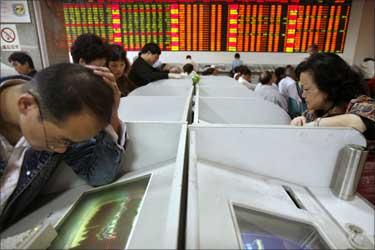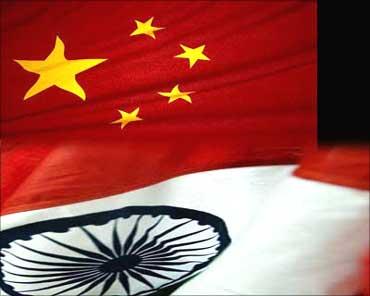
"In the next five years both India and China will continue to grow very fast. Both will struggle to gain influence in global decision-making that is commensurate with the size of their economies," says Arthur Kroeber.
In an e-mail interview with rediff.com, the Beijing-based managing director of GaveKal Dragonomics, an economic research firm, and editor of the China Economic Quarterly, explains why China will be a power to reckon with and what all India can do to attain greater growth.
China is likely to become the world's largest economy in a few years. Your opinion, please.
This year China will become the world's second biggest national economy, ahead of Japan, with a total GDP of over $5 trillion. It still ranks well behind the United States, whose economy is about $14 trillion, and the combined European Union economy, which is about the same size as the US.
If we assume that China's economy continues to grow at 12 per cent a year in nominal US dollar terms (8 per cent average real growth plus 4 per cent combination of inflation and currency appreciation), and the US grows at 5 per cent nominal (3 per cent real plus 2 per cent inflation), then China's economy will surpass the United States in 2025 to become the world's biggest economy, with a GDP of around $31 trillion.
It might happen a bit earlier or a bit later, but it is likely that by 2030 at the latest China's will be the world's largest national economy.
...

What, according to you, are the secrets of China's phenomenal economic prowess? Where had India gone wrong?
I am not so sure that India has 'gone wrong'. China's growth mainly derives from the following factors:
Very favorable demographics since the mid-1970s. Note that after 2020 China's demographics will become very unfavorable while India's continue to improve.
The main effects of favorable demographics are:
Effective mechanisms for mobilising national saving for investments in basic industry and essential infrastructure.
Pragmatic, investment-friendly economic policies. These include the decentralisation of much economic decision making to local governments, and the creation of incentives for local governments to compete for investment and economic growth.
Has China's rapid economic rise changed social welfare? Have the benefits touched the majority of its population?
Social welfare has improved dramatically in China. The vast majority of Chinese citizens have a much higher standard of living than 5, 10 or 20 years ago.
Inequality has increased, but that is mainly because of structural reasons: people get wealthier by moving into the cities, but the cities can only absorb so many people each year (approximately 12-15 million).
Those that are left behind on the farm see their incomes grow much more slowly than city dwellers. But eventually they will be urbanized and their incomes will catch up.
...

In India almost 37 per cent people live below the poverty line: what can New Delhi do more to make growth more inclusive and widespread?
Deregulate labour markets and dismantle barriers to investment. Also improve and make universal basic education (6-9 years) to enable more people to participate in the modern economy.
What do you think are India's economic strengths and weaknesses?
Strengths are good capital markets, a strong entrepreneurial business culture, and increasingly favorable demographics which mean that the labour force and the national saving rate will rise for another couple of decades.
With more resources available, India will be able to invest at a much higher rate and sustain an economic growth rate of 8-10 per cent a year for two or three decades.
Weaknesses are poor institutions, inflexible labour market, insufficient basic education, and unreasonable restrictions on certain kinds of investment activities, especially in labour-intensive industries that can provide the basis for long-term growth in an economy with a large labour force and low wages.
...

What role will the Chinese financial markets play in shaping global sentiments? Do you think Indian financial markets have the strength to play a global role?
China's financial markets are essentially closed to foreign participation, so they have no direct impact on global markets. But they have a sentiment impact because China's economy is so huge.
India's financial markets will play a similar role when India's economy is sufficiently large, in 10-15 years.
China is gobbling up major American brands. Will it be able to maintain this momentum?
Actually, China has gobbled up no American brands. The only exception is the IBM personal computer business which was bought by Lenovo. But the broader IBM brand remains untouched.
Chinese firms' big long term focus is on the fast growing domestic market. To the limited extent that they acquire foreign brands and technology, the aim is to strengthen their market position at home.
But for the most part Chinese firms do not have the financial or management expertise to integrate large-scale acquisitions of sophisticated foreign firms.
...

In the recent global turmoil, China's banks have remained largely unscathed. What are the reasons?
Because China's financial system is largely closed, the currency is non-convertible for capital transactions, and capital flows are heavily regulated.
21st century belongs to Asia. How true do you think is this statement?
It's a vague statement with no clear meaning. What we can say is that Asia's share of total global economic output will rise substantially, led by China and India.
China and India's combined GDP is approximately $6.5 trillion or about 11 per cent of the global economy of $60 trillion; however the two countries' share of global population is around 40 per cent.
So the combined share of global GDP will certainly rise, although it will probably not reach the population share. However the economic power of the US and Europe will remain very important, as those regions are still by far the most important sources of technological innovation.
...

What are the privileges and problems of China's socialist market economy? How would you compare them to the problems of the Indian economy?
The main strengths of China's system are the effectiveness of mobilising saving for productive investment in industry and infrastructure, and the ability of the government to identify, analyse and respond to a wide array of economic and social problems.
Some of these strengths derive from the economic reforms of the past 30 years but others -- especially bureaucratic capacity -- rest on 1,500 years of continuous bureaucratic governance, a history that is unique to China.
The weaknesses are an underdeveloped and inefficient financial system, and a political system that discourages innovation and insufficiently represents a diversity of interests.
On India's strengths and weaknesses, see above. India can benefit from a study of China in learning how to mobilize savings and improve the investment environment. However its political system responds to an entirely different social reality and it is unfair to compare the two systems.
Should China devalue its currency? Do you think a common Asian currency might evolve?
China's currency will probably appreciate against the US dollar at an average rate of 3-5 per cent a year over the next decade, based on China's faster economic growth rate.
A common Asian currency is impossible without some federal Asian political structure, which is inconceivable at present.
...

As US dollar is being devalued it is said that China, since it holds about $1 trillion US Treasury bonds, can actually hold Washington hostage in economic negotiations. How true is the statement?
The reverse is the case. If China sells its Treasury bonds, it must buy something else. There is no other asset class that can possibly absorb such a large amount of money. So long as it continues running big trade surpluses and accumulating foreign assets, China has no choice but to buy US treasury bonds. Therefore, it has no real leverage.
In the global economic arena, where do you see India and China in the next 5 years?
Both will continue to grow very fast. Both will struggle to gain influence in global decision making that is commensurate with the size of their economies.
Gaining that influence is a long and complex process that does not simply depend on sheer economic size, but the sophistication of governance institutions and the willingness to look beyond domestic concerns. On both of these latter counts both India and China are still quite under-developed.